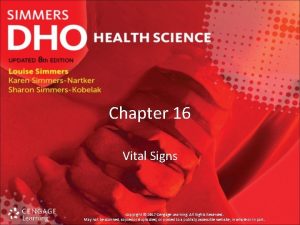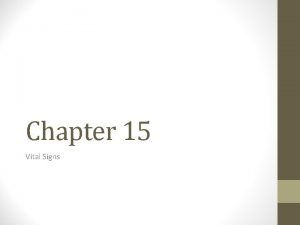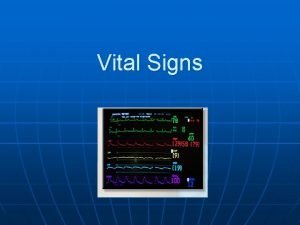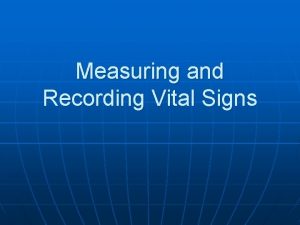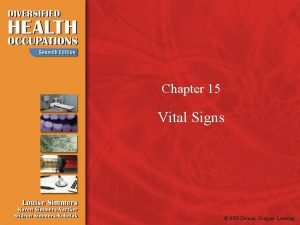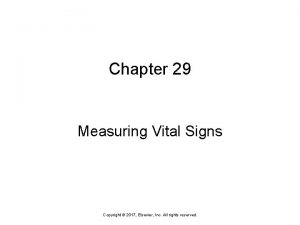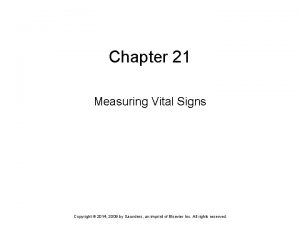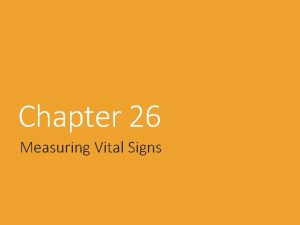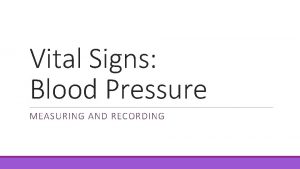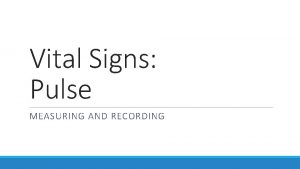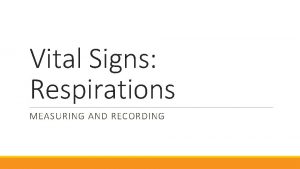Vital Signs Measuring and Recording Vital Signs VS









- Slides: 9

Vital Signs

Measuring and Recording Vital Signs (VS) n Record info about the basic body conditions • Temperature • Pulse • Respiration • Blood Pressure Accuracy is essential! Report abnormalities immediately

Measuring and Recording Temperature -Measures balance between heat lost and heat produced in the body -Heat produced by metabolism of food and by muscle and gland activity -Homeostasis: constant state of balance in the body -Conversion between Fahrenheit and Celsius temperature -Normal body temperature for humans is a range

Measuring Temperature n Temperature measurements— oral, rectal (often used on infants/children), axillary or groin, aural, and temporal • Most thermometers are digital now • Insert thermometer into patients mouth under the tongue • Postion it to the side of the mouth • Instruct the patient to keep it under the tongue by closing the lips around thermometer

Measuring and Recording Pulse n n Feel the pressure of the blood pushing against the wall of an artery as the heart beats and rests Locate a major arterial or pulse site • • n 1. temporal 2 & 3. carotid 4. brachial 5. radial 6. femoral 7. popliteal (behind knee) 8. posterior tibial 9. dorsalis pedis Check for rate, rhythm, and volume

How to Write Vital Signs n n n i. e. Temperature = 98. 6, Pulse = 72, Respiration = 16 Write: 98. 6/72/16 Or: 98. 6 – 72 – 16 Or: 98. 6 72 16 Always in that order: temp/pulse/resp

Measuring and Recording Respirations n n Measures the breathing of a patient One respiration: one inspiration (breathing in) and one expiration (breathing out)

Respirations cont. n 3 things must be measured • Rate – breaths per minute • Character – depth and quality (deep, shallow, labored, difficult, stertorus) • Rhythm – regularity of respirations (regular or irregular)

Summary n Summarize what you have learned so far about vital signs in 3 -5 sentences. Include the terms vital signs, temperature, pulse, & respiration
 Chapter 14:4 measuring and recording respirations
Chapter 14:4 measuring and recording respirations Chapter 16:3 measuring and recording pulse
Chapter 16:3 measuring and recording pulse Apical pulse
Apical pulse Measuring and recording temperature
Measuring and recording temperature Measuring and recording respirations
Measuring and recording respirations Chapter 15:1 measuring and recording vital signs
Chapter 15:1 measuring and recording vital signs Summary of vital signs
Summary of vital signs Chapter 29 measuring vital signs
Chapter 29 measuring vital signs Oral temperature
Oral temperature Guidelines for measuring vital signs
Guidelines for measuring vital signs

